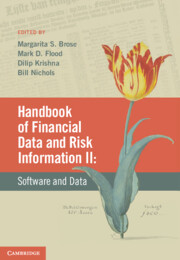Book contents
- Frontmatter
- Contents
- List of contributors
- Preface
- VOLUME II: SOFTWARE AND DATA
- PART IV DATA OPERATIONS IN FINANCIAL INSTITUTIONS
- PART V DATA MANAGEMENT TECHNOLOGIES
- 19 Financial data interchange standards
- 20 Data storage and processing
- 21 The extracting, transforming and transmitting of data
- 22 The visual analysis of financial data
- 23 Metadata management
- 24 Data security and privacy
- PART VI IMPLEMENTATION OF DATA AND ANALYTICS PROGRAMS
- Index – Volume II
- References
22 - The visual analysis of financial data
from PART V - DATA MANAGEMENT TECHNOLOGIES
- Frontmatter
- Contents
- List of contributors
- Preface
- VOLUME II: SOFTWARE AND DATA
- PART IV DATA OPERATIONS IN FINANCIAL INSTITUTIONS
- PART V DATA MANAGEMENT TECHNOLOGIES
- 19 Financial data interchange standards
- 20 Data storage and processing
- 21 The extracting, transforming and transmitting of data
- 22 The visual analysis of financial data
- 23 Metadata management
- 24 Data security and privacy
- PART VI IMPLEMENTATION OF DATA AND ANALYTICS PROGRAMS
- Index – Volume II
- References
Summary
Introduction
Financial risk analysis is cognitively complex and demands analysis and interpretation of diverse and often sizeable data sources. Whether the goal is to analyze systemic, market, liquidity, credit or operational types of risk, it is often the case that financial risk analysis and decision-making require rivers of data to be contextualized and analyzed across multiple dimensions on an almost real-time basis. The methods and technologies used to synthesize and analyze this flood of data, and to turn the resulting information into useful insights, are still few and far between. Traditional analytic methods and tools often force people to formalize their thoughts early in the process, and to adapt their way of working to the rigidity of mathematical formulas or computational methods. In contrast, risk analysis frequently requires open-ended exploration of large volumes of complex data, detection of previously unknown patterns, changes or anomalies, and seeking solutions to open-ended and even ill-defined questions. It is these challenges that visual analysis of financial data is designed to meet. Visual analysis technologies have the potential to reduce the time it takes to analyze complex financial data, to bring financial risk managers and decision makers to new understanding of their financial risks and to aid them in communicating about such risks. The goal of this chapter is to introduce the visual analytics approach, and to explore how it might support financial risk analysis and decision making.
Information
- Type
- Chapter
- Information
- Handbook of Financial Data and Risk Information IISoftware and Data, pp. 279 - 326Publisher: Cambridge University PressPrint publication year: 2014
References
Accessibility standard: Unknown
Why this information is here
This section outlines the accessibility features of this content - including support for screen readers, full keyboard navigation and high-contrast display options. This may not be relevant for you.Accessibility Information
- 1
- Cited by
